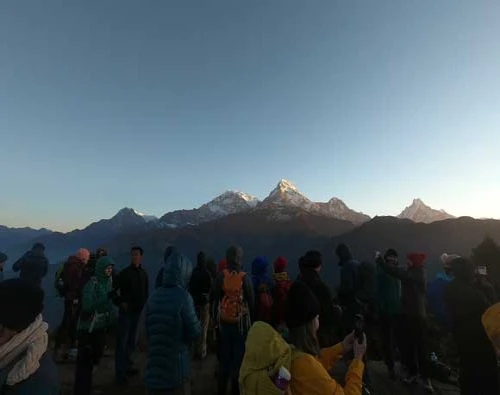Pokhara is a remarkable place of natural beauty. Situated at an altitude of 827m from the sea level and 200km west of Kathmandu Valley, the city is known as a center of adventure. This enchanting city has several beautiful lakes and stunning panoramic views of Himalayan peaks. The serenity of lakes and the magnificence of the Himalayas rising behind them create an ambiance of peace and magic. Pokhara city tour covers entire famous touristic places in Pokhara, from the majestic Himalayan ranges, sunrise, temples, stupas, cultures, and beautiful Fewa Lake.
Pokhara City Tour Covers:
Sarangkot Sunrise
Sarangkot is the most popular tourist destination from where the tourist can enjoy the great view of the Pokhara Valley and the magnificent view of the mountains. Sarangkot is only 5 km from Lake Side, Pokhara. Sarangkot is the highest viewpoint for a sunrise and it is just 1592m high. Sarangkot is 5 degrees cooler than Pokhara. Sarangkot can be reached easily in 45 minutes by a car ride to the top from Pokhara and then 45 minutes hike up to the main viewpoint.
GUPTESHWOR CAVE
This Cave is divided into two parts. The first parts are about 40 meters long; there are a natural cave and temple of Lord Shiva to visit the first you have to pay Rs 30 per person as the entry fee. In this first part, you are not allowed to take photos. The next parts start after the temple which way goes to the downside of Devi’s fall, a distance about 100 meters from the second entrance, from there you can see the view of Davis Falls, as well as natural rocks, Electric lights, are managed for the convenience of the visitor. After the Lord Shiva temple on the second part of this Cave, you are allowed to take photos. The second part is closed during 4 months of Monsoon (June, July, August, and September)
DEVI’S FALL
On 31st July 1961 A.D. in the afternoon, a sudden flood from Fewa Lake swept away a Swiss citizen, Mrs. Davis, who was bathing with her husband beside it. He was flawed and dead. It has taken its name “Devi’s Fall” Length: 500 meters underground water flow. Depth: 100 Feet. More attractive months: June, July, August, and September. Most people pronounce Devi’s fall as Davi’s fall. Locally known as Patale Chhango.
FEWA LAKE
Phewa lake and water sports are the main tourist attraction of Pokhara city and the north shore of the lake has developed into a tourist district, commonly called Lake-Side, with hotels, restaurants, and bars catering to the tourists. The water from the Phewa Lake outlet is used to generate electricity. The Phewa Power House has located about 1.5 km (0.93 mi) from the southern part of the Phewa Lake. A part of the lake is also used for commercial caged fisheries.
SETI RIVER
The Seti originates from the snowfields and glaciers around the twin peaks of API and Nampa in the south-facing slopes of the central Himalayas. The area is near the tri-junction of the borders of Nepal, India (Kumaon, Uttarakhand), and China (Tibet). The river first flows in a south-easterly direction, then turns and flows in a south-westerly and finally south-easterly again before joining the Karnali or Ghagra River. It has cut a spectacular gorge across the Mahabharata Range and appears to be lost amongst caves and tunnels for a short distance. The roaring Seti River passes through Pokhara, but you won’t see it unless you go looking. The river has carved a deep, narrow gorge through the middle of town, turning the water milky white in the process. At points, the gorge is less than a meter across and the river gushes by more than 50m below street level. The best place to catch a glimpse of the Seti River is the park near the KI Singh Bridge, just north of old Pokhara on the road to Balachaur.
BARAHI TEMPLE
This is the most important religious monument in Pokhara. Built almost in the middle of Phewa Lake, the two storied pagodas are dedicated to the boar manifestation of Ajima, the protectress deity representing the female force Shakti. Devotees can be seen, especially on Saturdays, carrying male animals and fowl across the lake to be sacrificed to the deity.
WORLD PEACE STUPA
The pagoda is a massive Buddhist stupa and is situated on top of a hill on the southern shore of Phewa Lake. Besides being an impressive sight in itself, the shrine is a great vantage point that offers spectacular views of the Annapurna range and Pokhara city. You can get there by crossing the lake by boat and then hiking up the hill.
- Sunrise and Panoramic mountains view.
- Waterfalls, Nature.
- Peaceful Lakes, Himalayan drop.
- Heritage, Culture, and Lifestyle.



.webp)
.webp)
.webp)



